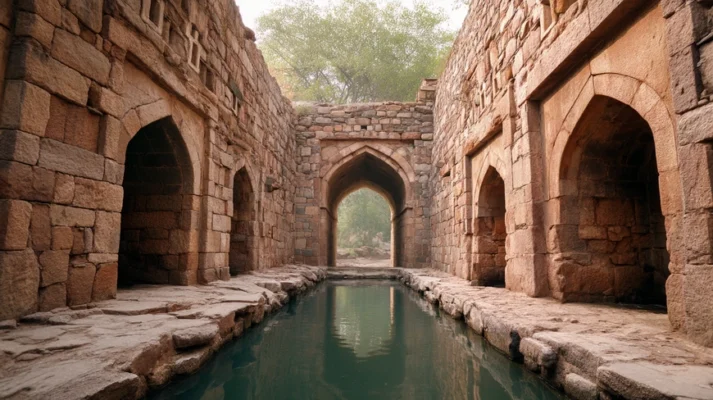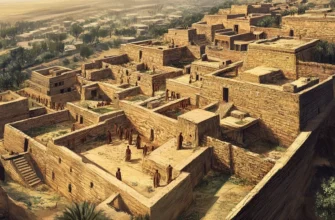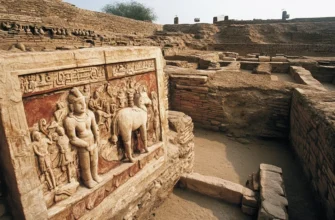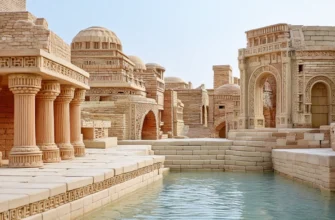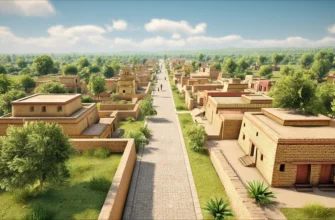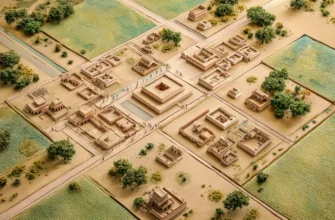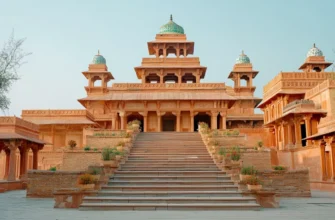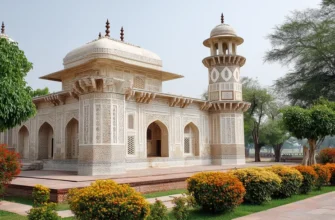The sewerage systems of ancient Indian cities, especially in Mohenjo-Daro, Harappa, and Lothali, were among the most advanced in the world. They included underground drains, drainage channels, and gutters lined with fired bricks. Houses had toilets and bathrooms connected to the city’s sewage system, as well as public toilets to maintain sanitation. This system kept cities clean and helped reduce disease. Despite the decline of the Indus civilization, its engineering achievements became the basis for the further development of urban infrastructure.
The water supply and sewage system in the cities of the Indus civilization was one of the most advanced in ancient times. It included wells, water storage tanks, and a complex network of underground drains and drainage channels. The streets of the cities had well-designed drainage systems lined with fired bricks. Residential buildings had bathrooms and toilets connected to a central sewerage system, which allowed for the efficient disposal of wastewater. This layout contributed to the cleanliness, hygiene, and health of the inhabitants, making the Indus cities some of the most comfortable places to live in ancient times.
Hygiene played an important role in ancient civilizations as it helped maintain the health of the population and reduce the spread of disease. In developed urban cultures, such as the Indus civilization, Ancient Egypt, Mesopotamia, and Rome, there were water supply, sewage, and public bath systems. People followed rules of personal hygiene, washed regularly, used aromatic oils, and applied natural remedies to cleanse the body. Public and religious buildings often had special reservoirs for washing. Thanks to their attention to cleanliness, ancient civilizations were able to improve the quality of life and create favorable conditions for the development of cities.
- Major cities with developed sewage systems
- Mohenjo-Daro
- Harappa
- Lothal
- Design and features of sewerage networks
- Domestic and public sanitation facilities
- The impact of the sewerage system on society
- Hygiene and public health
- Engineering achievements and their significance for future civilizations
- The decline and legacy of ancient Indian sewage systems
- Conclusion
Major cities with developed sewage systems
Among the cities of the Indus civilization that had developed sewage systems, the most famous are Mohenjo-Daro, Harappa, and Lothal.
Mohenjo-Daro is one of the largest cities of civilization, with a complex system of underground channels, public toilets, and private bathrooms connected to the drainage network. The streets were designed to ensure efficient drainage of wastewater.
Harappa is another large city where houses had separate toilets and water was supplied through wells. Public sewers ran along the streets and were covered with slabs for easy cleaning.
Lothal is a port city known not only for its sewage system but also for its shipyards.
The drainage channels were sloped to facilitate efficient water drainage, and the houses had drains connected to the general sewer system.
These cities demonstrate the high level of engineering thinking of the Indus civilization and their attention to hygiene and comfort for their inhabitants.
Mohenjo-Daro
Mohenjo-Daro is one of the largest cities of the Indus civilization, famous for its highly developed sewage system. Located in modern-day Pakistan, the city was built around 2600 BC and is a striking example of the engineering progress of the ancient world.
Mohenjo-Daro has a complex and well-planned sewage system. The streets of the city were laid out with slopes to facilitate the natural drainage of rainwater. Underground channels made of fired bricks ran along the streets and connected to larger drainage channels. This allowed for the efficient removal of sewage from the cities.
One of the most impressive aspects of the sewage system in Mohenjo-Daro is the separate toilets in each house, which were connected to a centralized sewage system. Sewage pipes ran under the houses, and sewage was discharged into external sewage systems. Most of the city’s buildings also had bathtubs, indicating a high level of hygiene and comfortable living for the inhabitants.
In addition, the city had public toilets with a similar sewage system, further confirming the high level of organization of the urban space.
All this together ensured cleanliness and reduced health risks for residents, demonstrating how important hygiene and infrastructure were to the ancient Indians.
The Mohenjo-Daro sewage system was one of the best in the world at the time of its existence and became an important achievement in the history of urban planning and engineering.
Harappa
Harappa is one of the largest cities of the Indus civilization, located in modern-day Pakistan, which existed from approximately 2600 to 1900 BC. The city became famous for its developed infrastructure, in particular its highly organized water supply and sewage systems.
Like Mohenjo-Daro, Harappa had a well-designed drainage system. The city used underground brick-lined channels that effectively drained wastewater from homes and streets. Most homes had indoor toilets connected to a common sewer system. What was unique was that all these sewer systems were connected to a central network, which kept the city clean.
The streets of Harappa were laid out with slopes to ensure natural drainage of rainwater and maintain hygienic conditions. In addition, the city had public water pipes and reservoirs for water storage, which were also part of the general water supply infrastructure.
The water supply and sewage system in Harappa was extremely efficient for its time. It ensured high standards of hygiene and health for the inhabitants, demonstrating the significant attention paid to engineering and planning in this ancient civilization.
Lothal
Lothal is an ancient city located in western India, in the modern state of Gujarat, which was part of the Indus civilization. Founded around 2400 BC, it became an important port for trade and, like other cities of this civilization, was renowned for its highly developed infrastructure.
One of the main features of Lothal is its advanced water supply and sewage system. The city had a well-planned network of canals for water drainage, which ensured street cleaning and sanitation. Gutters and drainage channels made of fired bricks ran throughout the city and connected to central canals for efficient wastewater disposal.
Lothal also had a specially constructed drainage system for the port area, which prevented water pollution in the sea and kept the port clean. This shows a high level of organization and attention to hygiene and public health.
Houses in Lothal had bathrooms and toilets connected to a common sewage system, similar to other cities of the Indus civilization, such as Mohenjo-Daro and Harappa. All this allowed for high standards of hygiene and ensured the comfort of the inhabitants.
Lothal, like other cities of the Indus civilization, demonstrates a high level of engineering thought of the time and is a striking example of the development of urban infrastructure and engineering in ancient India.
Design and features of sewerage networks
The design and features of sewerage networks in Indus civilization cities, particularly in cities such as Mohenjo-Daro, Harappa, and Lothal, were extremely sophisticated and advanced for their time. Here are some key features and design characteristics of sewerage systems:
Underground channels: The sewerage systems of Indus cities included underground channels made of fired bricks, which were laid under the streets. This ensured safe and efficient drainage of wastewater. The channels had a slope that allowed water to flow freely and not accumulate in urban areas.
Individual connections to the network: Most houses had special toilets and bathrooms connected to the central sewerage network. Water from these rooms was discharged through pipes and channels into a common drainage system that ran through the city and carried wastewater outside its boundaries.
Public and common drains: Cities had public drains — large channels running through the streets that provided drainage for rainwater and cleaned urban areas of dirt and pollution. The drains were covered with slabs to prevent clogging and facilitate maintenance.
Treatment system: In some cities, particularly in Mohenjo-Daro, the canals had treatment systems located at street intersections, where pollution could be removed and effective drainage ensured.
Garden city: Sewage systems in Indus cities were part of an overall urban strategy. Streets had clearly planned slopes for wastewater, which helped keep things clean and minimize health risks for residents.
Engineering solutions for port cities: In port cities such as Lothal, special channels were additionally designed to drain water from port areas, keeping them clean and preventing water pollution in coastal areas.
Overall, the design of the Indus civilization’s sewerage networks was a remarkable example of engineering skill and attention to hygiene, ensuring high standards of cleanliness and health for city dwellers.
Domestic and public sanitation facilities
Domestic and public sanitation facilities in the Indus civilization were important elements of urban infrastructure, ensuring high levels of hygiene and comfort for residents.
Domestic sanitation facilities
Many houses in Mohenjo-Daro, Harappa, and Lothal had specially designed toilets and bathrooms connected to a centralized sewage system. Indoor toilets, located near the walls of the house, were connected to underground channels that carried sewage into the general city network.
These toilets usually had seats made of stone or brick and sewer pipes that allowed for efficient waste disposal. Bathrooms were often built inside houses, with tiled floors and connected to the water supply through internal pipes. This indicates a high level of organization and attention to personal hygiene.
Public sanitary facilities
In addition to domestic toilets, cities also had public sanitary facilities. These were specially built toilets accessible to a wide range of residents, especially in areas with high population density. In some cities, such as Mohenjo-Daro, public toilets were large and equipped with seats for the convenience of users.
These public sanitary facilities were also connected to a centralized sewage system, which ensured effective wastewater disposal. Such facilities, in particular, helped keep cities clean, reducing the risk of infection and the spread of disease.
Both domestic and public sanitary facilities used underground channels to help drain wastewater efficiently. All these structures were part of a large water supply and sewage system that kept cities clean and created comfortable living conditions.
These sanitary structures testify to the high level of organization of the living space and the advanced engineering skills of the Indus civilization, as well as the considerable attention paid to hygiene and the health of the inhabitants.
The impact of the sewerage system on society
The sewerage system in the cities of the Indus civilization had a major impact on society, ensuring high standards of hygiene, sanitation, and comfort for residents. Its development can be viewed from several aspects:
Improved hygiene and health
Sewerage systems, in particular underground channels for the disposal of wastewater, significantly improved hygienic conditions. The removal of dirty water and sewage reduced environmental pollution and lowered the risk of disease. This ensured cleanliness in cities, which contributed to the preservation of public health.
Conservation of water resources
Effective sewerage helped prevent the pollution of water sources such as rivers, lakes, and reservoirs. Water used for domestic purposes could be quickly and safely disposed of, keeping the water ecosystem in good condition.
Making everyday life easier
Having a centralized sewer system made everyday life way easier for people. Houses had indoor toilets and baths, which were comfy and convenient. Public toilets let people stay clean and healthy even in big cities where there were a lot of people.
Urban environment management
The sewerage system kept urban areas clean. Streets, with drainage ditches and gutters, were designed to prevent water from accumulating, reducing the likelihood of flooding and keeping the city tidy. This created favorable conditions for the development of trade and business.
Social and economic benefits
A well-developed sewerage system improved the standard of living, which had a positive impact on social and economic aspects. Clean cities promoted the development of entrepreneurship, trade, and crafts, as they were attractive to residents and traders. In addition, the reduction in disease increased labor productivity and reduced healthcare costs.
Cultural aspect
Cleanliness and order in cities also had important cultural significance. Hygiene was linked to religious and social norms. In many civilizations, hygiene was considered not only a matter of health but also of moral purity. High standards of hygiene contributed to the creation of a culture of cleanliness and order in society.
Engineering progress
The development of sewerage systems was an important stage in engineering progress, enabling civilization to achieve a high level of urbanization. This laid the foundation for the development of cities that were able to withstand large population flows, expand, and improve.
Thus, sewerage systems had a major impact on the development of society, not only improving living conditions but also contributing to economic growth, culture, and scientific and technological progress.
Hygiene and public health
Hygiene and public health were among the key aspects of the development of civilizations such as the Indus civilization, where advanced sewerage and water supply systems had a direct impact on the overall health and well-being of the population. The high level of attention to hygiene in cities such as Mohenjo-Daro, Harappa, and Lothal reduced the risk of disease and improved the quality of life of residents. Here are some aspects that indicate the importance of hygiene for public health:
Prevention of infectious diseases
Effective sewage and water supply systems significantly reduced the risk of infectious diseases such as dysentery, cholera, and other diseases transmitted through contaminated water and poor sanitation. Clean streets, centralized drainage, and toilets connected to the sewer system prevented the contamination of water sources and reduced the likelihood of disease spreading among the population.
Improved living conditions and personal hygiene
A city with a developed water supply and sewage infrastructure provided residents with clean water for drinking, cooking, and personal hygiene. Bathrooms and indoor toilets in homes provided comfort and convenience for maintaining personal hygiene. This contributed to improving the health of the population, in particular by increasing cleanliness and reducing health risks associated with the lack of basic sanitation.
Prevention of water-related diseases
Developed water supply and sewage systems helped prevent water pollution and reduced the likelihood of water-related diseases. Treating wastewater before it was discharged from the city kept rivers and lakes clean, ensuring a safe water supply and preventing diseases caused by contact with contaminated water.
Maintaining sanitation in public places
Public toilets and sanitary facilities in cities such as Mohenjo-Daro helped keep places where large numbers of people lived clean. The availability of such facilities reduced the risk of diseases that can arise from poor hygiene in densely populated areas.
Development of a culture of hygiene
High standards of hygiene in cities, which included not only sewage and water supply but also street cleaning systems, became part of cultural and social norms. This contributed to the formation of a culture of cleanliness and health among the population, which in turn had a positive impact on the overall level of well-being.
Preservation of the natural environment
High standards of hygiene and sewerage systems helped to maintain the ecological balance in cities by reducing environmental pollution. Clean streets, sewerage, and effective water management not only improved the health of residents but also contributed to an overall improvement in the quality of life.
Social and economic benefits
Improvements in hygiene and health had a direct impact on economic stability and social development. A healthy population was less prone to illness, which reduced healthcare costs and ensured greater productivity. People who did not have health problems could work longer and contribute to the development of the economy and culture.
Overall, the high level of hygiene in the cities of the Indus civilization was an important factor in ensuring the health and well-being of the population. Engineering achievements in water supply and sewage systems significantly influenced the quality of life and overall well-being of society, reducing the risk of disease and maintaining comfort.
Engineering achievements and their significance for future civilizations
The engineering achievements of the Indus civilization, particularly in the field of water supply and sewage systems, were of enormous importance not only for the society of that time, but also for the development of future civilizations. The high level of engineering skill in these areas laid the foundation for many achievements in urban planning, hygiene, and technology that influenced the development of cities and societies in the centuries that followed.
Engineering achievements in the construction of sewage and water supply networks
The Indus civilization, particularly its cities such as Mohenjo-Daro and Harappa, had one of the most advanced water supply and sewage systems of its time. Underground channels that carried away sewage, as well as a system of public toilets connected to a centralized sewer system, showed how engineers of that era could effectively organize the urban environment.
These achievements became the basis for future engineering developments in Roman and Arab civilizations, which later improved water supply systems, as well as for the development of engineering in Europe in the Middle Ages.
Development of urban planning and city planning
The cities of the Indus civilization were planned with convenience for residents in mind, as well as with an emphasis on sanitary conditions. Streets were laid out with slopes for natural drainage, which helped to avoid flooding and the accumulation of dirt. Sewerage systems, which ensured the efficient disposal of wastewater, were also important for public health.
This planning was an important step in the development of urban planning and became a model for subsequent civilizations, including the Roman Empire, where a whole complex of water supply and sewerage networks was also developed in cities.
Impact on the further development of hygiene and health care
Engineering achievements in water supply and sewerage directly influenced the level of hygiene and health in cities. Thanks to such systems, it was possible to reduce the spread of diseases transmitted through contaminated water or sewage, which was an important step in the development of medical and hygienic standards.
This was a prerequisite for the development of sanitation in ancient and medieval civilizations, as well as for the creation of state and public institutions that ensured hygienic standards for the population, such as Roman baths or medieval aqueducts in Europe.
Technological innovations
The engineers of the Indus civilization used technologies that allowed them to create complex structures, including underground waterways and canals. They used fired bricks to lay channels and build drains, which ensured the long-term operation of these systems.
This became the basis for further technological innovations that appeared in other cultures, such as the creation of Roman aqueducts, which became the basis for modern water supply and sewage systems.
Contribution to the development of architecture and construction
The engineering achievements of the Indus civilization also had a major impact on the development of architecture and construction. A high level of knowledge in architecture and engineering allowed for the creation of structures that were not only functional but also aesthetically pleasing. This was also of great importance for future architectural achievements in other cultures.
Social stability and development of society
Well-organized sewage and water supply systems made it possible to meet the basic needs of the population, which contributed to social stability and the development of civil society. When cities were able to maintain high standards of hygiene and health, this created conditions for economic development, cultural progress, and social organization.
These principles remained relevant in later civilizations, where hygiene and health became important aspects of government and urban planning.
The Indus civilization’s engineering achievements in water supply and sewage became the basis for the development of engineering and urban planning in subsequent cultures. They not only influenced the development of infrastructure, but also became an important factor in maintaining public health and creating comfortable living conditions. These achievements ensured further progress in many aspects of civilization, from hygiene to technology, and influenced the development of societies for thousands of years to come.
The decline and legacy of ancient Indian sewage systems
The decline and legacy of ancient Indian sewage systems is an important aspect of the history of Indus civilizations. Although these systems were extremely advanced for their time, they did not survive intact due to the decline of the cities themselves and changes in socio-political conditions.
However, the legacy of these achievements continued to influence future civilizations and technological progress.
The decline of the Indus civilization’s sewage systems
The decline of the Indus civilizations, particularly cities such as Mohenjo-Daro and Harappa, was probably caused by a combination of factors, including climate change, falling river levels, and possible economic and social upheavals. This led to the decline of infrastructure, including sewage systems. In some cases, canals and drains were filled in, and with the development of new forms of agriculture, the need for such complex engineering solutions declined.
However, even during the period of decline, many elements of the water supply and sewage systems remained in the city for several centuries, testifying to the high level of engineering achievements.
Preserving heritage for future civilizations
Despite the decline of the Indus sewerage systems, their legacy had a major impact on subsequent civilizations.
Ideas and technologies related to water supply and sewage disposal were adopted and improved by the Romans, Arabs, and other peoples in the ancient and medieval world.
Roman civilization:
The Romans significantly improved the water supply and sewage systems by developing aqueducts and large underground sewage networks (for example, the Cloaca Maxima, one of the oldest sewage systems still in operation today). They also applied some engineering principles that had already been used in India.
The Islamic world:
In the Middle Ages, Arab countries, which inherited knowledge from ancient and ancient Indian cultures, also developed complex water supply and sewage systems. Engineers and scientists of the Arab world improved water purification and aqueduct construction technologies using principles that probably had their roots in Hindu practices.
Technical heritage and its influence on the present day
The legacy of ancient Indian sewerage systems is reflected in technical achievements in urban planning, architecture, and engineering. Many modern sewerage systems, including those used in modern cities, continue to use principles that can be traced back to the ancient civilizations of the Indus Valley.
Engineering achievements, particularly in the field of water drainage and sewage, laid the foundation for the development of modern water supply systems, which include complex water and wastewater treatment mechanisms, underground communications, and centralized systems.
Significance for cultural and scientific heritage
The sewerage systems of the Indus civilizations also have cultural significance as examples of engineering achievements and innovation in the ancient world. They testify to the high level of organization of society and knowledge of hygiene, ecology, and infrastructure, which was important for ensuring the stability and well-being of the community.
The engineering achievements of these civilizations, particularly in water supply and sewerage, have become an important part of the scientific heritage that continues to influence our understanding of engineering, ecology, and hygiene today.
Symbols of sustainability and technological progress
The legacy of ancient Indian sewerage systems reminds us of the importance of stability and scientific progress for the development of societies. Modern cities use the latest technologies based on principles established in ancient times. These ancient achievements are symbols of how engineering innovations can contribute to the development and prosperity of society, retaining their significance through the centuries.
The decline of ancient Indian sewerage systems did not mark the end of their influence. On the contrary, these systems became part of a cultural and engineering heritage that inspired and continues to influence the further development of civilizations. Their achievements, particularly in water supply and wastewater disposal, laid the foundation for future technological innovations that contributed to the development of the urban environment and ensured the health and well-being of the population.
Conclusion
The sewerage systems of ancient India are not only evidence of the high level of engineering skill of the time, but also an important component of the development of urban planning as a whole. They not only met the basic needs of the urban population for water supply and drainage, but also became the basis for a healthier and more comfortable living environment.
The principles of effective water resource management, competent planning of urban networks, and developed infrastructure became models for subsequent civilizations, which began to use their experience in their own cities.
The sewerage systems of ancient India were of great importance for the development of urban planning, as their design and organization were directly linked to improving the quality of life of city dwellers. Skillful planning of urban water supply and sewage networks helped prevent natural disasters such as flooding, reduce the spread of disease, and ensure proper sanitation. Such engineering solutions became the basis for subsequent civilizations, particularly in Rome and the Arab world, which adopted the principles of effective water resource management and urban infrastructure.
The experience of ancient India demonstrates the importance of a comprehensive approach to urban infrastructure development, particularly sewage systems. These lessons are still relevant today:
The importance of planning and engineering for the urban environment. Ancient Indus engineers demonstrated the importance of careful planning of sewage and water supply systems for the health and well-being of urban communities.
Conservation of environmental resources. They made efficient use of natural resources, particularly rivers, and carefully organized their drainage systems to reduce the risk of pollution. Modern cities must take environmental considerations into account when planning infrastructure.
Maintenance and modernization. As the experience of ancient India shows, regular maintenance and modernization of infrastructure are essential for its long-term operation. This is critical in the context of rapid urban development and population growth.
Hygiene as the foundation of health. Ancient India understood the importance of sanitation for public health, and these lessons should be taken into account when designing modern water supply and sewage systems to prevent disease.
An innovative approach to the use of materials. The use of fired bricks for the construction of canals and aqueducts shows how important it is to find materials that can ensure the durability of infrastructure even in difficult conditions.
The experience of ancient India serves not only as a historical example but also provides important lessons for modern cities, where engineering, ecology, and hygiene remain important components for ensuring sustainable development and well-being.
